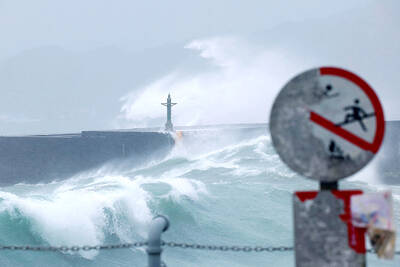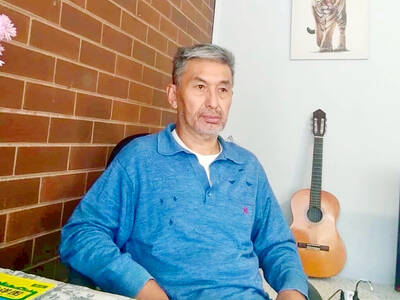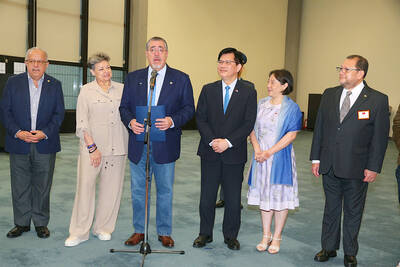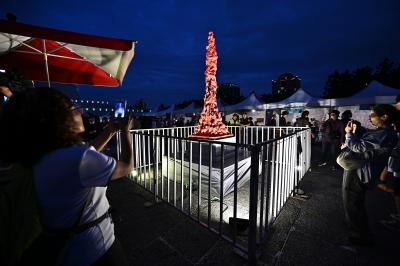Lee Rong-chang (
The men said their boss -- Chen Yi (
He never came back.
Every year on March 10, Lee's family has squid congee to commemorate the loss of their father. The family still does not know what happened to him.
They suspected his disappearance might have had something to do with his advocacy of judicial independence and call for hiring Taiwanese people in government agencies.
Sixty years have passed since the 228 Incident took place, but the whole truth behind the massacre and the events which followed during the White Terror era still remain shrouded in mystery.
228 Incident
The 228 Incident was a military crackdown on civilian protests that started on Feb. 27, 1947, against the Chinese Nationalist Party (KMT) administration.
Historians estimate that around 30,000 people were killed.
Textbooks usually portray the incident as the result of a conflict between anti-contraband officers and local people after officials attempted to confiscate cigarette products from a vendor named Lin Chiang-mai (林江邁), who did not have a sales permit from the government.
After she was injured and a bystander was killed, crowds of demonstrators demanded that the killers be punished. The protesters were met with gunfire, igniting widespread public protest the following day.
Military assistance
To resolve the conflict, Chen requested military assistance from Generalissimo Chiang Kai-shek (
Tens of thousands of people were either killed, injured or went missing within months of the crackdown, the greatest losses were reported in Keelung, Taipei, Chiayi and Kaohsiung.
While some of the facts remain unclear, former Chinese Nationalist Party (KMT) chairman Ma Ying-jeou (
The Taipei City Government released a documentary earlier this year in which the incident is interpreted as "a pure misunderstanding resulting from language barriers." The 228 Memorial Foundation published a book in February last year claiming that the KMT should be held responsible for the 1947 massacre, because its leader at the time, Chiang, as well as Chen Yi, the man he had appointed executive administrator of Taiwan, had been the masterminds behind the incident.
KMT Legislator John Chiang (
John Chiang has also said that he planned to sue President Chen Shui-bian (
White Terror
What followed the 228 massacre has been labeled the White Terror era. Numerous people were arrested and more lives were lost when martial law was declared.
Most of the victims were prominent Taiwanese, including lawyers, prosecutors, doctors, professors and media workers.
There is no official tally of the number of people who were jailed, went missing or lost their lives.
A private group dedicated to investigating the early years of the White Terror era, from 1949 to 1954, placed the number of deaths at 4,000. The group estimated 150,000 people were jailed and 120,000 went missing.
After Chiang Kai-shek's Nationalist troops lost the civil war to the Communists and withdrew to Taiwan in 1949, the KMT regime launched a nationwide campaign to "eliminate communist spies."
Suspects were either executed without proper trials or sent to Green Island for "rehabilitation."
Those who survived found it difficult to fit into society and were under constant surveillance.
They were isolated because no one dared to associate with them and they were frequently refused promotion at work because of their "tainted" background.
`Scoundrels'
Declassified documents indicate that the KMT had provided the Taiwan Garrison Command with lists of names of "scoundrels" who had to be eliminated following the 228 Incident.
It remains a mystery who provided the lists, which names were on the lists and who carried out the operation.
Efforts to study the 228 Incident did not begin until 1987, when martial law was lifted. The government did not apologize to victims' families until former president Lee Teng-hui (
Lee ordered the Cabinet to form an ad hoc foundation to offer subsidies to victims and their families.
Figures released by the foundation show that it has distributed more than NT$7.1 billion (US$215.3 million) to 9,420 victims and their families since its establishment in 1995.
As of December last year, the foundation had received 2,756 claims, 2,264 of which have been deemed valid, while 464 were turned down because of insufficient evidence.
President Chen has also apologized on behalf of the government and has announced plans to turn the ad hoc foundation into a standing body.
He also designated Feb. 28 as a national holiday, erected a national 228 monument, established a national museum, declassified documents relating to the massacre and presented national certifications to victims and their families to restore the reputations of people who had been dubbed "hooligans" during the KMT's reign.
During Chen Shui-bian's term as Taipei mayor, he established a municipal 228 museum and turned the Taipei New Park into the 228 Peace Park.
Despite the government's apologies, some relatives still cannot forgive the government, saying that surviving perpetrators behind the regime of repression remain unknown and unpunished.
Some have urged the government to amend school textbooks to reflect the facts of the incident, but many just want the truth. Kenneth Wang (
Wang's father was taken away on March 14, 1947. His family still do not know what happened to him. Kenneth Wang was only two years old and his younger brother three months when the incident took place.
His family originally did not know Lee Rong-chang, but the same fate brought the two families together. The Wangs moved in with Lee Rong-chang's family so they could take care of each other. Together, the two families and many others living in the same neighborhood who had also lost family members launched a desperate but futile search for their loved ones.
Kenneth Wang, director of the San Diego chapter of the Formosa Association for Public Affairs (FAPA), was sent to the US in 1968 by his mother, who was afraid that he would be the next target. He has been in the US ever since.
Written apology
Speaking on behalf of the victims of the 228 massacre and their families residing in the US, Wang said that they would like to see the KMT offer a sincere, written apology to them and all Taiwanese people.
They also want to know who provided the blacklists to the Garrison Command and who was in charge of the investigation office of the KMT's Taiwan chapter during the massacre.
Finally, they want to see the KMT make a contribution to the state coffers equal to the amount the 228 Memorial Foundation had paid to victims and their families.
Lee Rong-chang said he would like to see the legislature change the law regulating the "subsidies" offered to victims and their families to a "compensation" bill, because compensation would imply that someone had admitted to having made a mistake.
"Only when the perpetrators admit their mistake will victims and their families be able to forgive them and move on with their lives," he said.

Greenpeace yesterday said that it is to appeal a decision last month by the Taipei High Administrative Court to dismiss its 2021 lawsuit against the Ministry of Economic Affairs over “loose” regulations governing major corporate electricity consumers. The climate-related lawsuit — the first of its kind in Taiwan — sought to require the government to enforce higher green energy thresholds on major corporations to reduce emissions in light of climate change and an uptick in extreme weather. The suit, filed by Greenpeace East Asia, the Environmental Jurists Association and four individual plaintiffs, was dismissed on May 8 following four years of litigation. The

A former officer in China’s People’s Liberation Army (PLA) who witnessed the aftermath of the 1989 Tiananmen Square massacre has warned that Taiwan could face a similar fate if China attempts to unify the country by force. Li Xiaoming (李曉明), who was deployed to Beijing as a junior officer during the crackdown, said Taiwanese people should study the massacre carefully, because it offers a glimpse of what Beijing is willing to do to suppress dissent. “What happened in Tiananmen Square could happen in Taiwan too,” Li told CNA in a May 22 interview, ahead of the massacre’s 36th anniversary. “If Taiwanese students or

DIPLOMACY: It is Guatemalan President Bernardo Arevalo’s first visit to Taiwan since he took office last year, while Eswatini’s foreign minister is also paying a visit A delegation led by Guatemalan President Bernardo Arevalo arrived in Taiwan yesterday afternoon and is to visit President William Lai (賴清德) today. The delegation arrived at Taiwan Taoyuan International Airport at 4:55pm, and was greeted by Minister of Foreign Affairs Lin Chia-lung (林佳龍). It is Arevalo’s first trip to Taiwan since he took office last year, and following the visit, he is to travel to Japan to celebrate the 90th anniversary of diplomatic relations between the two countries. Arevalo said at the airport that he is very glad to make the visit to Taiwan, adding that he brings an important message of responsibility

About 3,000 people gathered at events in Taipei yesterday for an annual candlelight vigil commemorating the 1989 Tiananmen Square Massacre, a brutal crackdown by Chinese authorities on a student-led demonstration in Beijing on June 4 36 years ago. A candlelight vigil organized by the New School for Democracy and other human rights groups began at 7pm on Democracy Boulevard outside Chiang Kai-shek Memorial Hall, with the theme "Resist Transnational Repression, Defy Totalitarianism." At about 8pm, organizers announced that about 3,000 people had attended the event, which featured brief speeches by human rights advocates from Taiwan and China, including Hong Kong, as well